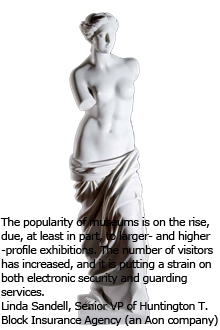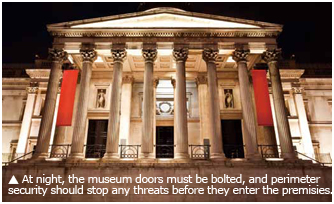Discovering and surveying our cultural heritage is the first step to understanding who we are. Museums house priceless artifacts and artworks while opening their doors to countless curious visitors from all over the world. Thousands of patrons pass through the hallways on a daily basis — children on school trips, pressing their noses against the glass case to better view a small ornament from the Macedonian period and tourists who have flown thousands of miles to catch a glimpse of the Mona Lisa in person.
Discovering and surveying our cultural heritage is the first step to understanding who we are. Museums house priceless artifacts and artworks while opening their doors to countless curious visitors from all over the world. Thousands of patrons pass through the hallways on a daily basis — children on school trips, pressing their noses against the glass case to better view a small ornament from the Macedonian period and tourists who have flown thousands of miles to catch a glimpse of the Mona Lisa in person.
Museum curators and security directors are met with the challenge of balancing security with aesthetics. While protecting cultural property is a must, security devices should not take away from the design of the interior or obstruct the visitor's ability to thoroughly enjoy the display.
Museums and historical sites are at greater risk today than before. “Many historical sites can no longer rest on their laurels,” said Tony Makosinski, Head of Marketing for the U.K. and Ireland, Security and Custom Electronics, Honeywell International. “They need to generate additional revenue streams, and as a result, many of these magnificent buildings are becoming alternative venues for corporate functions and weddings. This means that the security system protecting the site, and its expensive artifacts and displays, needs to be updated to make it flexible enough to cater to the free movement of people within the building, while maintaining a high level of protection.”
Still, far too often poor security specification, inadequate maintenance and a failure to audit systems leave senior museum staff in blissful ignorance and with a false sense of security, said Charles Hill, an art risk consultant.
 The threat of terrorism is also something new that museum directors have been facing over the past few years. “The museum's content and the facility itself may have a strong emotional tie to the community or global recognition,” said Sheila Palmer, Assistant VP of Loss Control Services, Chubb Group of Insurance Companies. “In addition, a museum may be a place where large numbers of people gather. These qualities make museums a potential target.”
The threat of terrorism is also something new that museum directors have been facing over the past few years. “The museum's content and the facility itself may have a strong emotional tie to the community or global recognition,” said Sheila Palmer, Assistant VP of Loss Control Services, Chubb Group of Insurance Companies. “In addition, a museum may be a place where large numbers of people gather. These qualities make museums a potential target.”
Currently, people are looking into renewing historical buildings and integrating/upgrading existing surveillance systems, said Stefan Van Waelderen, President of Bussap. Although security systems and measures are necessary, budgeting is always a concern. “The reality is that most museums struggle with budget considerations and often cannot afford to upgrade,” said Linda Sandell, Senior VP of Huntington T. Block Insurance Agency (an Aon company).
At the National Palace Museum of Taiwan, the allowance for security fluctuates each year. “Our budget changes depending on our security needs. Generally, we are only spending money on maintenance, which does not take up too much of the budget,” said Jo-Hsin Chi, Chief Curator, Department of Registration and Conservation. “However, for our last project which included a new wing, security took up 10 percent of the overall budget.”
The market will continue to grow as museum directors understand the necessity of using technology to protect and run their facilities. “It's true that the global recession has impacted the market; however, technology will drive the market as it starts demonstrating cost efficiencies,” said Phil Barwell, Product Marketing Manager, ADT Fire & Security.
For instance, while a system does not negate the need for uniformed guards, it is possible to decrease the number of guards necessary to secure the premises. This is because less men would be required to patrol the hallways and they would only need to react to any possible threats they are alerted to by the system. “We save on the associated spending such as salaries, benefits and training costs. One major university museum saved US$30,000 in the first six months of operation,” said Dan Lazuta, Director of Sales and Marketing, Acuity-VCT.
 DECISION MAKINGMBR
DECISION MAKINGMBR
The technology and the system implemented at a museum/historical site go beyond the choices made by the director. Often, insurance companies will dictate the level of security required as it directly affects the type of insurance coverage given. “Most artworks are of a high intrinsic value and are often donated to the gallery or museum by benefactors,” said Daniel Wan, Head of Marketing for the U.K., Control and Safety Systems, Honeywell International. “As a result, there is a great responsibility to not only secure these assets from theft, but to also prevent the cost of insurance from spiraling.”
Generally, the more valuable an item, the greater coverage it receives and the more stringent the security requirements are as required by insurance companies. “Since art is irreplaceable, monetary proceeds from fine art insurance can only provide funds to purchase new artwork, but can never restore a priceless collection,” Sandell said. “That is why fine-art insurers place a heavy emphasis on the prevention of losses through requirements for state-of-the-art security and fire protection systems.”
Risk assessments are done by insurance companies prior to drafting insurance agreements. “Many museums, security consultants and insurance companies use the Smithsonian Institute security guidelines as a benchmark when conducting their assessments,” Palmer said.
Inadequate security measures will result in higher insurance premiums. “Each institution should purchase the best system they can afford based on their individual needs. Having proper protection will almost always result in more favorable insurance terms and pricing,” Sandell said.
STOPPING RISKS AT THE PERIMETER
The first step to protecting a museum or historical site would be to identify ways in which to stop or deter the threat before it enters the premises. “Outdoor perimetersecurity for sites like museums is a growing market, since much of the security focus on this market is on the inside of the facility. One must think beyond the standard considerations of threat and budgets because other considerations like aesthetics, weather and environment come into play and need to be part of the security decision,” said Cathy McHugh, Director of Marketing, Senstar.
While video surveillance is probably the most common technology found, security and building managers are looking into other means, such as prevention or deterrence, as well as assessment, to supplement cameras, McHugh said. Emphasis is now placed on setting up a perimeter security system to go along with a video surveillance system to provide a complete solution.
 In order to refrain from diminishing the aesthetics of the area, detectors can be used to create a virtual fence around the site without having to erect a physical fence or wall, said Jon Sinar, Regional Sales Manager for Singapore, Xtralis. “Site systems usually include a perimeter fence line, which can be in excess of 1.5 kilometers. Depending on the terrain, we would advise that no single technology be utilized — instead, a number of technologies, such as motion detectors and passive IR sensors, should be incorporated to provide zones of approximately 60 meters in length and combined with CCTV. Together, they can create a virtual fence around the site and look into key areas.”
In order to refrain from diminishing the aesthetics of the area, detectors can be used to create a virtual fence around the site without having to erect a physical fence or wall, said Jon Sinar, Regional Sales Manager for Singapore, Xtralis. “Site systems usually include a perimeter fence line, which can be in excess of 1.5 kilometers. Depending on the terrain, we would advise that no single technology be utilized — instead, a number of technologies, such as motion detectors and passive IR sensors, should be incorporated to provide zones of approximately 60 meters in length and combined with CCTV. Together, they can create a virtual fence around the site and look into key areas.”
Cable sare used whenever allowed, and measures are taken to ensure the system is working properly. “All perimeter cables are monitored through end-of-line resistors, which can alert authorities to anyone tampering with the lines or to a faulty cable. Also, all cables are capable of generating fault alarms in real time to test for faulty transmission,” Sinar said. “If a problem is found, a backup line will take over to allow investigation into the issue. This helps limit the down time of the system by monitoring the system's integrity.”
By setting up a proper perimeter around a museum or site, it can limit the manpower required to patrol the grounds. “Instead of tasking the guards with the duty to detect an intrusion, it is common for the guard to be given other duties and be tasked with simply responding to an intrusion,” Sinar said. “When an intruder breaks in, the system can issue an audio warning, remotely operate lights at the site and inform the guard on duty of the location of the intrusion. In some cases, backup is sent to the site if the intrusion is deemed hostile, although most intruders will flee once they know they have been spotted.”
Next - Part Ⅱ:Securing and Preserving Cultural Heritage